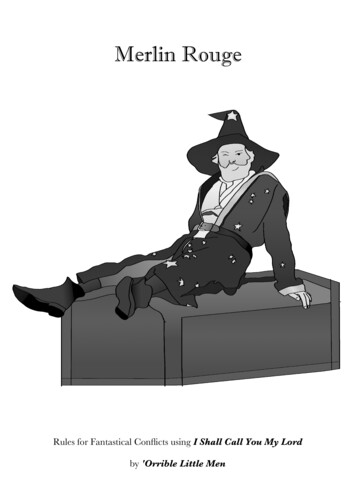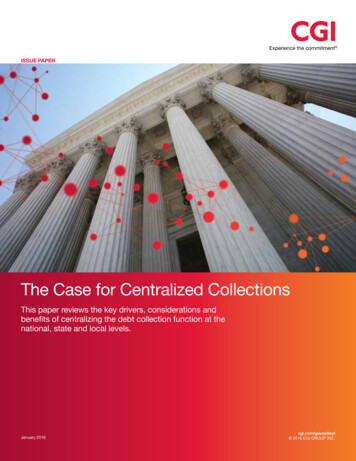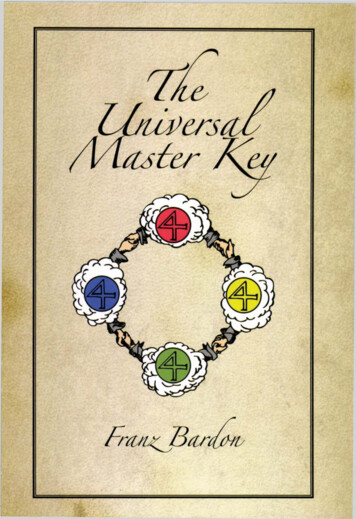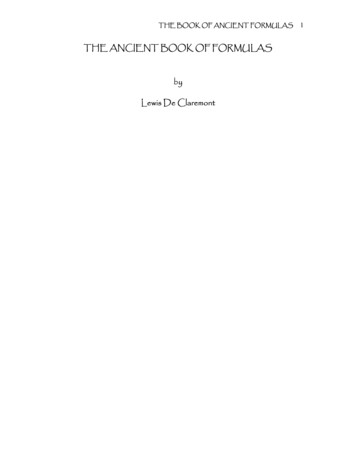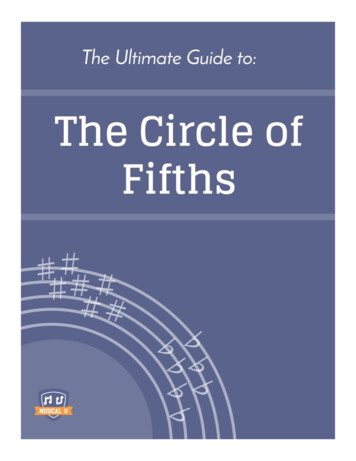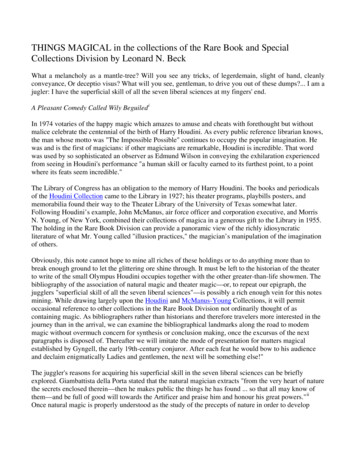
Transcription
THINGS MAGICAL in the collections of the Rare Book and SpecialCollections Division by Leonard N. BeckWhat a melancholy as a mantle-tree? Will you see any tricks, of legerdemain, slight of hand, cleanlyconveyance, Or deceptio visus? What will you see, gentleman, to drive you out of these dumps?. I am ajugler: I have the superficial skill of all the seven liberal sciences at my fingers' end.A Pleasant Comedy Called Wily Beguiled iIn 1974 votaries of the happy magic which amazes to amuse and cheats with forethought but withoutmalice celebrate the centennial of the birth of Harry Houdini. As every public reference librarian knows,the man whose motto was "The Impossible Possible" continues to occupy the popular imagination. Hewas and is the first of magicians: if other magicians are remarkable, Houdini is incredible. That wordwas used by so sophisticated an observer as Edmund Wilson in conveying the exhilaration experiencedfrom seeing in Houdini's performance "a human skill or faculty earned to its furthest point, to a pointwhere its feats seem incredible."The Library of Congress has an obligation to the memory of Harry Houdini. The books and periodicalsof the Houdini Collection came to the Library in 1927; his theater programs, playbills posters, andmemorabilia found their way to the Theater Library of the University of Texas somewhat later.Following Houdini’s example, John McManus, air force officer and corporation executive, and MorrisN. Young, of New York, combined their collections of magica in a generous gift to the Library in 1955.The holding in the Rare Book Division can provide a panoramic view of the richly idiosyncraticliterature of what Mr. Young called "illusion practices," the magician’s manipulation of the imaginationof others.Obviously, this note cannot hope to mine all riches of these holdings or to do anything more than tobreak enough ground to let the glittering ore shine through. It must be left to the historian of the theaterto write of the small Olympus Houdini occupies together with the other greater-than-life showmen. Thebibliography of the association of natural magic and theater magic—or, to repeat our epigraph, thejugglers "superficial skill of all the seven liberal sciences"—is possibly a rich enough vein for this notesmining. While drawing largely upon the Houdini and McManus-Young Collections, it will permitoccasional reference to other collections in the Rare Book Division not ordinarily thought of ascontaining magic. As bibliographers rather than historians and therefore travelers more interested in thejourney than in the arrival, we can examine the bibliographical landmarks along the road to modemmagic without overmuch concern for synthesis or conclusion making, once the excursus of the nextparagraphs is disposed of. Thereafter we will imitate the mode of presentation for matters magicalestablished by Gyngell, the early 19th-century conjuror. After each feat he would bow to his audienceand declaim enigmatically Ladies and gentlemen, the next will be something else!"The juggler's reasons for acquiring his superficial skill in the seven liberal sciences can be brieflyexplored. Giambattista della Porta stated that the natural magician extracts "from the very heart of naturethe secrets enclosed therein—then he makes public the things he has found . so that all may know ofthem—and be full of good will towards the Artificer and praise him and honour his great powers." iiOnce natural magic is properly understood as the study of the precepts of nature in order to develop
natural powers, and not to violate natural laws as black magic does, its relationship with science ismanifest.Speaking for science, one of its founding fathers, Francis Bacon, wrote in the New Atlantis: "We thathave so many things truly natural, which induce admiration, could in a world of particulars deceive thesenses, if we would disguise these things, and labour to make them seem more miraculous." iii Themiracles of natural magic, like those of science, are miracles only in the etymological sense of callingforth admiration. Since this, of course, is the one effect for which the juggler strives, he wrapped himselfin the cloak of the natural magician and adapted to his purposes the achievements of nature science.Natural MagicBut his dominion that exceeds in this, Stretcheth as far as doth the mind of man: A sound Magician is aDemi-god.Christopher Marlowe. Doctor FaustusAgrippa's portrait as it appears on the title page of third book of De Occulta Philosophia (1533), expresses thequalities of dignity and strength 'which are his contribution to the concept of the magician. Frances Yatescomments in Giordano Bruno and the Hermetic Tradition (Chicago: University of Chicago Press, 1964) p.142,that "For Agrippa necromancy and conjuring were Renaissance in spirit, not the old hole-in-the corner businessof the persecuted medieval magician. They come invested with the noble robes of Renaissance magic, with thedignity of the Renaissance Magus."It was Robert-Houdin, greatest of Houdini's precursors, who defined the stage magician as an actorplaying the role of a magician. The prototype magician is, then, the amalgam of fact and fiction createdof such awesome figures as Albertus Magnus, Trithemius, Paracelsus, or Agrippa von Nettesheim.These were natural magicians because they had mastered "the secret miracles of nature" (the phrase isthe title of Lemnius' De miraculis occultis naturae, Frankfurt, 1611) and their knowledge was literallypower. The most elevated Renaissance depiction of the natural magician is Prospero in Shakespeare'sTempest. The most famous exponent of Renaissance natural magic, and of Renaissance skepticism, wasthe ambiguous' Agrippa von Nettersheim (1486?-1535) who influenced William Blake and AlbrechtDurer, and whom young Dr. Frankenstein read before beginning his unhappy experiments.Agrippa's De Incertitudine et Vanitate Scientarum (translated in the McManus-Young, London, 1674copy as The Vanity of Arts and Sciences), which concludes that all human knowledge is riddled witherror, was written at the same time as the three books of his De Occulta Philosophia. [1674 is a typo inthe essay. The work was published in 1694.] Perhaps Agrippa saw no contradiction in rejecting theknowledge of his time for a new knowledge to be achieved by illumination, revelation, or thereinterpretation of an ancient esoteric doctrine.
Image from Henry Cornelius Agrippa’s fourth book of De Occulta Philosophia. Turner's Paracelsus, of 1656It is indicative of the complex intellectual atmosphere of the period that this occult text should be preceded bysix verses from Cambridge scholars praising the translator's work. Five years later Newton came to CambridgeUniversity. Robert Turner fought a rearguard action against the displacement of the Renaissance animisticworld view by the new mechanistic one. Turner's Paracelsus, of 1656, announces his intention of publishing the"famous art of Steganography, Authore Tritemio, to speak our own language, and perhaps the OccultPhilosophy of Agrippa digested into a plainer method."The first book of the De Occulta Philosophia treats of the natural magic of the four elements (earth, air,fire, and water) of this sublunary "elemental" world. Printing was began in 1531, interrupted by theInquisitor Conrad Colyn of Ulm, and resumed in 1533. The 1531 edition was described by DavidClement's Bibliotheque Curieuse (1750) as "presque entierement disparu." The Lessing J. RosenwaldCollection on the history of the illustrated book has both editions of this fons et origo of natural magic.Its demon-conjuring hardcore black magic explains the similar rarity of the apocryphal fourth book ofthe De occulta philosophia. The Rare Book Division has a copy of the London edition of 1655 of thisheady pseudo-Agrippa cum cabala mixture. Houdini owned the 1855 German edition published byScheible of Stuttgart, the bookseller -publisher specializing in Faustiana. The fourth book, perhaps morethan the others, justifies Robert Southey's description of the Agrippine texts:The letters were written with blood therein And the leaves were made of dead men's skin.Cornelius Agrippa; a BalladThe dedicatory epistle of De occulta philosophia is addressed to Agrippa's teacher, the Abbot JohannesTrithemius. (1462-1516), whom librarians know as a founder of universal bibliography, but who wasfamed in his own time for having resurrected the shade of Anne of Brittany. The story has beenexplained as an ingenious use of mirrors or of an early version of the magic lantern elaborated by Portaand Athanasius Kircher in the next two centuries. Popularized by the "Fantasmagorie" theater, set up inNapoleonic France by Etienne Robertson (whose Memoires Recreatifs of 1831-33 are in the HoudiniCollection), the magic lantern is a standard component of parlor-magic literature, appearing, forexample, as the first item Popular Amusements (Philadelphia, 1838) in the Rare Book Division'sJuvenile Collection.
Trithemius' Polygraphia, the first book on codes and ciphers, is represented in the George FabyanCollection on the Shakespeare-Bacon controversy by two copies of the first edition of 1518 and byseven other printings. In addition, the Fabyan Collection holds the 1606, 1621, 1655, 1676, and 1721editions of Trithemius' Steganographia, the second book of which purports to tell how to transmitthought without words. Called "second sight" when adapted to the stage, this quasi-telepathy is furtherrepresented in the Fabyan Collection by three editions (1641, 1694, 1695) of Bishop Wilkins' Mercury(subtitled "shewing, how a man may with privacy and speed communicate his thoughts to a friend at anydistance"). It is seen once more in the section on the imagination in Sylva Sylvarum when Bacon recallsthat a visitor at his father's house one day told a spectator what card another spectator would take in ademonstration of the psychological "force."After Agrippa the greatest name in natural magic is that of Giovanni Battista della Porta, (1535?-1615),the intention of whose Magiae Naturalis is to take natural magic entirely away from the devil. "Hismagic is natural because the forces used are objectively present in nature, like the magnet whichmysteriously points to the north. Porta's introduction announces that "I shall observe what our ancestorshave said; then I shall shew by my own experience, whether they be true or false." He requires themagician to know mathematics perfectly, to master optics, and to be rich, for without money nothing canbe done in these matters. The work grew with time; the original four books became 20 in the Naples(1589) edition. The emphasis also changed, moving always toward the utilitarian, until Porta's naturalmagic becomes like that combination of household hints, workshop notes, kitchen and sick room recipesand miscellaneous "half-told half-truths" known as the literature of secrets.Houdini's copy of Robertson's work. Most popular of the presentations listed in his Petit repertoire fantasmagorique (1:294-304) was "Young burying hisDaughter." The "Fantasmagorie" was one of the channels by which the Night Thoughts of the English poet Edward Young influenced French romanticism.In London the contemporary equivalent of the "Fantasmagorie" burned Moscow before the eye of Napoleon at every performance.
The fontispiece of Natural Magick (London: Printed, T. Young and S. Speed, 1658) is the work of R Gaywood, a pupil of W.Hollar. Porta calls his book Chaos because it is an omnium gatherum of information not easily fitted elsewhere. Book 17 includesa clear description of the camera obscura with and without lens (chapter 6) and proposals for the combined use of convex andconcave lenses (chapter 10), which give Porta claims to the invention of both telescope and microscope. Porta charged that hisBook 7, on magnetism, was stolen by Gilbert, whose De magnete added only "the mad idea" that the Earth is in motion.This woodcut is thought to be the work of the "Petrarch Mailer" of the Burgkmair workshop m Augsburg. Trithemius is the figureon his kneel offering the book to the Emperor Maximilian. Behind him, holding out the keys to the Polygraphia, is the publisher,Johannes Haselberg. In the lower part of the frame a reclining Trilhemius displays all the accouterments of his churchly office.The runners issuing from his heart carry sketches of mathematicians, astronomers, and other savants with the instruments of theirscience. Trithemius’ coat of arms is in the lower left corner: the scallop shells, associated with St. James of Compostela, are alsothe symbols of the Sponheim Abbey. Martin Luther's Tischreden records a conversation m 1539 in which Luther said thatTrithemius paraded before Kaiser Maximilian all the deceased emperors and great heroes one after another, as they were whenalive, as well as Anne of Brittany, whom Charles VIII of France had wooed away from Maximilian.
The title of Houdini's 1680 Nurnberg edition of Porta, Magia naturalis oder Haus-kunst- und wunderbuch, epitomizes this change. It also makes clear the dependence on Porta of Wolffgang Hildebrand,father of the so-called Hausvater natural magic genre, whose Magia naturalis, Das ist Kunst undwunderbuch Houdini owned in the 1614, 1663, and 1704 editions.Robertson of the "Fantasmagorie" describes the Magiae naturalis as "my first manual, to which I owemost of my taste for experimental physics." Houdini calls it "the first really important and exhaustivework on the subject," although regretting that it explained tricks without precisely recording theirinventors. Houdini's demand is, perhaps, not an entirely reasonable one to make of a Renaissancemagician. The Rare Book Division holdings of Porta's Magiae naturalis include three Plantin editions(1561, 1564, 1576) and the editions of Cologne (1563), Naples (1589), Frankfurt (1597), Hanover(1619), Leiden (1644), London (1658), Amsterdam (1664), and Nurmberg (1680).Reginald Scot (1538?-1599) differs from Agrippa as much as Scot's treatise on hop-growing, A PerfitePlatforme (1576), differs from his Discoverie of Witchcraft (1584). Since the extortion of the proof ofconclusions previously determined by the torture of old women is not a pleasant theme, we would havepreferred to ignore the great witchcraft controversy of the 16th century. The one book that must not beignored is Scot's Discoverie, particularly pages 287-352, which are headed "Natural Magic" and werecut and pasted by the hacks who wrote books with their scissors for the next 200 years. Without Scotthere would be far fewer pages in the little 18th-century books associated with Henry Dean and titledsome variation on Hocus Pocus or, the Whole Art of Legerdemain, which are the collector's delight.A Type or Figure of the Circle for the Master and his Fellows to fit in, shewing how, and after what fashion it should be made.This Circle for the Master to fit in, and his fellow or fellows at first calling, lie back to back, when he calleth thespirit; and for Fairies make this circle with chalk on the ground, as is said before. This Sp? Being once calledand found, shall never have power to hurt the Call him in the hour of ? or ? the ? increasing."Printed for Andrew Clark, and . . to be sold at Mr. Cotes's near the Golden-Ball in Aldersgate-Street," the volume from which the above detail comes in avery rare variant (the Library's copies may be the only ones extant) of the 1665 edition of Scot's The Discovery of Witchcraft. All issues of this edition add asecond discourse on devils and spirits and preface the 15th book with nine chapters that explicitly contradict Scot's original by accepting the existence ofdiabolical witchcraft and elaborating on its practices. Scot has been accused of seeking success by including materials sure to interest the would-bepractitioner. The 1665 edition adds six more formulas for the invocation of spirits to Scot's 10 and subtly calls attention (to other arcane matters by puttingthem into Latin. The tone and texture of the interpolations are such that it is impossible to believe that the anonymous writer did not deliberately set out togive the public a quasi-grimoire.
To prove the absurdity of witchcraft, Scot demonstrated that the juggler, a popular entertainer, could dothings "more, or at least no less strange in working miracles" than those attributed to witchcraft, and dothem entirely by natural means. He testified that jugglers are God-fearing men, some of them indeed"greatlie commendable." He himself had studied the art, his teacher being a certain John Cautares.Agrippa talks of the juggler in the De incertitudine, but this passage may be among the first to mentionone juggler specifically and to praise them all. Before Scot, the juggler was one of the travelingpeople—the fire-eaters, bear trainers, and rope dancers—whom the law punished for the great sin of notbeing seen to work. The Discoverie can be said to defend the juggler and legitimatize his arts bycloaking them in natural magic.To cut off one’s Head and to lay it on a Platter, which the Jugglers call the decollations of John the BaptistScot’s "Decollation of John Baptist" is the ultimate ancestor of all "sawing-a-woman-in-half" tricks. A reading of his text willmake clear what happened on stage in the decapitation scenes of dramas like Marston's The Insatiate Countess (act 5, scene 2) orMassinger's Virgin Martyr (act 4, scene 3). The decollation was then so frequently performed that a piece of doggerel ran: "Noknife shall cut this throat in twain/No juggler rend this jug’lar vein." Of course, any audience suspects a draped table underwhich it cannot see, and Scot's last direction is "not to suffer the companie to state too long in place" after the illusion.Title page of The whole Art of Ledgermain: or Hocus PocusThe "Henry Dean" of 1635 styles the decollation, featured as the frontispiece for Hocus Pocus, "How to cut a Man's head off and to put the Head into aPlatter, a yard from the body," calling it "a noble action, if it be handled by a skillful Hand." The trick varied little from Scot's, pictured in the Discovery ofWitchcraft in 1684.
To cut off one’s head, and lay it in a Platter, which Jugglers call the decollations of John the Baptist. Strange Feats are hereintaught by Slight of Hand, With which you may divert yourself and Friend. The like in Print was never seen before. And to You’llsay, when once you’ve read it o’er.On the other hand John Dee (1527-1608), Merlin of Elizabethan England and the author of Monahieroglyphica (1564), is a natural magician whose very real scientific achievements have been obscuredby his association with entertainment. When Dee was teaching Greek at Oxbridge he produced somesort of drama in which strange figures flew across the stage, and tables moved by themselves, "whereatwas great wondering," froin which wondering Dee was never able to clear himself. A somewhat similarsituation is described in Andrew Oehler's Life, Adventures and Unparalleled Sufferings (Trenton, NJ1811). In 1806 Oehler was in Vera Cruz, doing balloon and fireworks exhibitions. One night, becausethe governor was in the audience, Oehler gave as an added attraction a magic lantern ghost show,summoning spirits who appeared in smoke and fire to the accompaniment of thunder and lightning. As aresult he found himself in solitary confinement in a cell for six months. Dee, however, never got out ofthe cell of his bad name.It is impossible to resist quoting from the introduction to the first English edition of Euclid the lines inwhich Dee berates his contemporaries: "O unnaturall Countreymen. O unthankfull countreymen. OBrainsicke. Rashe, Spiteful!, and Disdainful! Countreymen. Why oppresse you me, thus violently, withyour slaundermg of me: Contrary to Veritie: and contrary to your owne consciences?" He goes on todeny any culpable action: "And for these, and such like marvelous Actes and Feates, Naturally,Mathematically, and Mechanically, wrought and contrived: ought any honest Student, and ModestChristian Philosopher, be counted, & called a Conjurer?Dee’s introduction to the first English translation Euclid defines thaumaturgike asthat “art Mathematicall. which giveth certain order to make straunge workes, ofthe sense to be perceived and, and of men, greatly to be wondered at." Hisdefinition recalls Porta’s concept of magic as miraculous in the sense of evokingwonder and admiration. The figure in the center of the Monas hieroglyphica titlepage is Dee’s sign for the monad, essentially the common alchemical andastrological sign for Mercury, to which has been added the upper half of thecommon sign of the first division, Aries. The symbol was used for a bookmark byJohn Winthrop, the '17th century governor of Connecticut, who owned—and used—a very large alchemical library.
What Dee called "thaumaturgke"—in shocked amazement at the devices he himself contrived—is rootedin the Pneumatics of Hero of Alexandria, which is used by Porta in the 19th book of the 1589 Naplesedition of Magiae Naturalis to illustrate the devices possible to the natural magic of air, water, andsteam. In the same year Hero appeared in the engagingly entitled Italian translation Gli Artifitiosi etCvriosi Moti Spiritale of Giovanni Aleotti. surveyor-engineer for the city of Ferrara, architect of theTeatro Farnese at Padua. The 1592 Italian translation by Alessandro Giorgi of the Urbino court, whoscolds Aleotti for his errors in philology, is in the John Davis Batchelder Collection of "characteristicexpressions of human activities." The general collections of the Rare Book Division hold a copy of the1575 Latin translation by Commandino, translator and mathematician at the same court, which isrepeated in the 1680 Amsterdam printing in the McManus-Young Collection, which also holds the 1647Bolognese reprinting of Aleotti. The coupling of Hero and Ramelll (the 1588 and 1620 editions of LeDiverse et Artificiose Machine are in the Rosenwald Collection) will yield the automatons that are theprincipal stock-in-trade of the early 19th-century magician. Hero's work has been described as anexample of the Greek fascination with the Pygmalion theme; might not the 18th- and 19th-centurypleasure in the automatons be an extension of the popular admiration for the mechanics of theNewtonian world? The literature of secrets previously alluded to, while often associated with thosecheats for which the craftsman is termed crafty, is part of natural magic insofar as it seeks to adapt oralter nature by natural methods. The most famous book in this literature is the Secretes of AlexisPiemont, attributed to Ruscelli; one of the Library's seven 16th-century copies of this Renaissancebestseller is in the Katherine BittingCollection on gastronomy. The adaptation of this literature to theuses of illusion can be illustrated by John Bate's Mysteryes of Nature and Art (1631, 635, 1654), in theRosenwald Collection because Bate thinks the illustrated book one of the mysteries of art. A Frenchexample is Lemery's effort at science popularization called Recueil des Curiosities Rares & Nouvelles,of which appear in both the Bitting and Elizabeth Pennell gastronomical collections.In the tradition of the literature of secrets, although its author is too versatile even by Renaissancestandards to be subsumed in only one tradition, is the De subtilitate in which Girolamo Cardanoexpounds on the wonders of the natural world. In his bibliography of the literature of secrets, JohnFerguson 1 grew enthusiastic over the Glasgow University copy of the 1554 Latin edition as a fineexample of what the book arts of the 16th century could do with a book meant for ordinary circulation.The reader in the Rare Book Room can share his pleasure. (The Library's copy even retains both clasps.)The title of the French edition (1556) makes manifest Cardano's place in natural magic: De la Subtilite,& Subtiles Inuentions, Ensembles les Causes Occultes, & Raisons d'icelles. Trevor Hall 2 points out thatas late as 1715 Thomas Hill’s Legerdemain carried the phrase "As Cardano saith" in its trickdescriptions. The 16th book of De Subtilitate is given over to arithmetic. The materials on mathematicsin the facsimile edition of Cardano'; omnia opera now under way amply evidence that Cardano wasworking on probability theory a hundred years before Pascal. Goethe called Cardano one of those menwith whom posterity will never be finished."The Seven Liberal Sciences"No doubt but magicke may doe much in this,For be that reades but Mathematicke rules,Shall finde conclusions that availe to worke1
Wonders that passe the common sense of men.Robert Greene. The Honorable Historie of Frier Bacon, and Frier Bongay (1594).Agrippa said that "the proportion of numbers" can "draw the soul upwards" so that mathematicstranscends reality. Cardano knew that mathematics also underlies reality since it is the arch-synthesizerof useful knowledge. The magician, whose work requires that his left hand know precisely what his righthand is doing, early saw in mathematics a good source for his repertoire. In the section on the art ofjuggling in The Discovery of Witchcraft, Scot comments that. "there are likewise diverge featsaythmeticall geometricall," adding "for them read Gemn Frisius." The reader in the Rare Book Roomcan find Gemma Frisius in the editions of the Aritmeticae Practicae Methodus Facilis published in1556,1557, and 1558 in Lyons, Pans, and Lepzeig respectively.The making of “golden rain.” From Mathematicall Recreations.The first to occupy himself directly with what is now called recreational mathematics-the ProblemesPlaisans et Dilectables qu. se Font Parles Nombres, to repeat the title of his 1612 publication-wasBachet de Meziriac, member of the Academie francaise, student of Ovid, Aesop, and Greek arithmetic.Twelve years later the largely borrowed Recreacion Mathematique appeared. Hitherto attributed to theJesuit Jean Leurechon the book is a double bibliographic puzzle, first, because of original title pageattribution of authorship to Henry van Etten; second because of the unidentified contribution to theEnglish translation by William Oughtred, inventor of the straight logarithmetic slide rule. The revisionof the Pollard and Redgrave Short Title Catalogue now under way will incorporate Trevor Hall'sfindings on this problem. The Library holds the second French edition 1629), two Dutch editions(167172, 1673) and three English editions (1633, 1653, 1674) of what will be called Van Etten. The kind ofelementary mindreading taught by this book can be sampled in the section titled "Many cards beingoffered to sundry persons, to find out which of these cards any one thinketh upon." The student oftechnology will find pleasure in the curious little illustrations scattered throughout Van Etten's text toexplain devices like the magic flask which the conjuror uses to pour liquids of three different colors.
The German representative of this literature of intellectual diversion is the potpourri of puzzles andtricks in physics and mathematics called by Daniel Schwenter his Deliciae Physico-mathematicae. TheHoudini copy of Schwenter is the three-volume edition, of which the last volume published in 1692, isnoteworthy because it concludes with a “Register der scribenten" which is, in effect, a bibliography ofsources. Primacy in recreational mathematics returned to the land of Descartes with the publication byJacques Ozanam (1640-1717), member of the Institut royal, of his Recreations Matherruitiques etPhysiques. The preface mentions Bachet but not Van Etten, certainly through denigration rather thanignorance. Ozanam describes himself as a gentlemen's tutor in mathematics in peace and a writer onmathematics in times of war. In Louis XIVs dreary dynastic wars, Ozanam's bibliography grew too longfor repetition here. Ozanam's fourth volume in the second edition is the classic in this literature. Itcarries the momentous subtitle Avec I'explication des tours de gibeciere, de gobelets, & autres recreatifs& divertissans.Turning pages in Ozanam, one notes in the section on arithmetic a problem that legend says was posedby Alcuin at Charlemagne's court: how to transport a wolf, a goat, and a cabbage to the other side of ariver, one by one, without ever leaving on the same side "the possible edible with the probable eater."The section on optics describes the properties of plane, concave, and convex mirrors to teach, forexample, how to shoot from over the shoulder. (Did Buffalo Bill read Ozanam?) The sleights with cupsand balls and the tricks with cards, cords, and knots are designated as "tricks of skill" or "amusingtricks."For the historian of science the London editions are the most interesting of the Library's holdings ofOzanam (London, 1708, 1756, 1803, 1814, 1844; Dublin, 1765; Paris, 1735-41, 1750, 1778, 1790). Theeditor-reviser of the McManus-Young 1803 London edition was Dr. Charles Hutton of the RoyalSociety and the text of Ozanam he used had been edited by Jacques Montucla of the Institut, so that thisedition represents the work of three mathematicians, each eminent in his own right, Montucla assertsthat he edited Ozanam mathematically, that is, by addition, subtraction, and correction. The last Englishedition was edited and revised by the astronomer Edward Riddle.This portrait of Henri Decremps prefaces Codicile de Jérome Sharp, Professeur de Physique Amusante, 1791 edition.
It is not certain that it is Edme Gilles Guyot the balloonist who is the author of the NouvellesRecreations Physiques et Mathematiques of 1769. The tide is an implicit acknowledgment of Ozanam'spriority, but Guyot added new material on gases, electricity, and magnetism "and the amusement andagreable astonishment that can be derived from them." In comparison with Ozanam, Guyot'sexplanations seem simple and he does provide the magician with some usef
The Rare Book Division has a copy of the . London edition of 1655 . of this heady pseudo-Agrippa cum cabala mixture. Houdini owned the 1855 . German edition. published by Scheible of Stuttgart, the bookseller - publisher specializing in Faustiana. The fourth book, perhaps more than the
